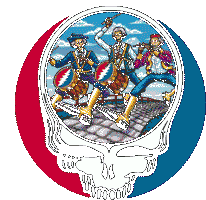Hippies are Hip

So says the Times Leader:
Still groovin’ on the 60's
By BILL REED
McClatchy Tribune News Service
He’s an old hippie and he don’t know what to do
Should he hang on to the old
Should he grab on to the new
He’s an old hippie ... his new life is just a bust
He ain’t trying to change nobody
He’s just trying real hard to adjust
—Bellamy Brothers, “Old Hippie”
Peace, love and flowers ... forever. It’s been 40 years since the Grateful Dead became the house band at acid tests in Golden Gate Park, since the word “hippie” assaulted the ears of confused “straights,” since music and culture began a period of wild, careening change.
But it’s not the anniversary that’s remarkable. It’s the fact that hippie culture never went away. Disco is dead. New Wave is nuked. “Leave it to Beaver” is a distant dream. The ’60s, though, are still groovy, for young and old alike.
“It’s totally true,” said Samantha Sloan, 25.
“Right, because the ’80s aren’t cool. But the ’60s ...”
Wear a poodle skirt or a leisure suit, and people will ask you if it’s Halloween. Wear tie-dye, long hair and granny glasses, and people won’t look twice as your VW microbus rumbles by.
“Jerry Garcia is bigger now than he was when he was young,” said Bud Ford, 61, former mayor of Manitou Springs, Colo., and owner of The Dulcimer Shop on the town’s main drag. “I didn’t affect the Jerry Garcia hair and beard until I was retired from my profession.”
Janis, Jimi, Jim and Jerry have ascended into the pantheon of rock-music immortals. The Dead’s jam-based rock has mushroomed into an entire genre, and festivals like Bonnaroo look an awful lot like Woodstock.
The peace sign is still cool. The devil horns, not so much.
Sure, part of the reason is those pushy baby boomers throwing their weight around, insisting that their formative years were the most exciting in the history of the nation.
But it’s an easy sell.
“It was an innovative generation. They actually did (stuff) — civil rights, women’s rights — while we just live on our parents’ couches until we get kicked out,” said Sarah LaPlante, 22. “Everybody wants to go back.”
LaPlante works at The Poppy Seed in Manitou Springs, Colo., a “one stop hippie shop” stuffed full of flowing skirts, scarves, incense and glass pipes. Essentially, it sells ’60s nostalgia and ideals, and it does well.
“This entire town is run by hippies,” LaPlante said. “We have a lot of regulars. A lot of positive vibes flow in this place. And the music ... they don’t make music like that anymore.”
LaPlante said the people she went to college with idolized the 1960s to such a degree that it has become a Golden Age in the minds of dreamers. At the same time, young people feel like they can’t live up to what their elders did.
Of course, there are slightly more cynical explanations for the eternal appeal of the hippie.
“Marijuana,” said Bard Griffin, 19. “Also, the fact that the ideas of free love and communal living are very appealing. It’s naturally appealing to teenagers. It’s appealing to me.”
Marijuana may sound like a flip answer, but it goes to the core of ’60s appeal: When someone brings up that decade, it’s the counterculture that springs to mind — teenage rebellion, war protests and drug culture.
We see “the ’60s” through a cloud of smoke.
The 1960s was also the decade of “The Sound of Music” and Jackie’s pillbox hat, the Cuban Missile Crisis and color TV. Yet we think of Wavy Gravy rather than Willie Mays, Haight-Ashbury instead of the Heartland.
“From January 1960 to December 1969, everything changed, seemingly at a faster pace than in any American decade since,” Stuart Shea wrote in “The 1960s Most Wanted.” “Life in America went from black and white to color, not just on the nation’s TV screens but in fashion, racial matters and popular culture.”
Griffin put his finger on why people his age idolize the ’60s: “There’s always a resurgence in anything that had to do with teenage rebellion.”
Journalist Alan Bisbort — who cut his teeth writing for underground hippie publications in the ’60s and is author of the counterculture flashback books “Rhino’s Psychedelic Trip” and “The White Rabbit and Other Delights” — defined hippie culture as “the possibly naive belief that a better world is possible.”
That belief is eternally inviting to the young and the optimistic.
And as another unpopular war rages overseas, it’s not surprising that people look back to the Vietnam era, even if they aren’t staging massive protests.
“See, I can’t believe there’s not more anti-war demonstrations,” said tourist Dennis Rowse, 61, during a visit to The Dulcimer Shop. “It’s got to be coming from our youth.”
Rowse is a retired school principal visiting from Arizona; he is not an anarchist radical, and he has no interest in protests himself. Yet, the activist spirit of the ’60s leaves him looking askance at young people today who aren’t taking to the streets.
Tie-dye, long hair and Grateful Dead bootlegs are fine, but baby boomers like Rowse are frustrated that people want to buy the 1960s rather than live the ideas.
Griffin and LaPlante agree with him, indicting their generation as lazy do-nothings.
Some boomers, however, hold out hope for younger generations.
“I think it’s much more of a lifestyle affectation than a way of life right now,” Bisbort said. “But if the military draft goes through, you will see a dramatic change in that equation. If they’re not pissed off about that, then I don’t know what would piss them off. I think there’s an underlying potential for great rage that may become a potential for great optimism.”
With Bisbort’s big-tent definition of “hippie,” it’s not about tie-dye or even the ’60s but the desire for progressive social change.



0 Comments:
Post a Comment
<< Home